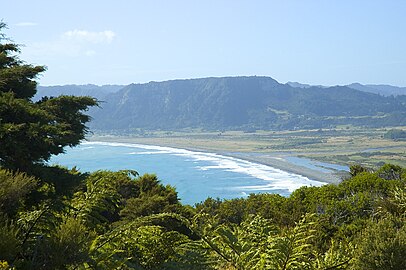East Cape
East Cape | |
|---|---|
 East Cape on the right hand end of the Raukūmara Range | |
| Coordinates: 37°41′21″S 178°32′54″E / 37.6892°S 178.5483°E | |
| Location | Gisborne District, New Zealand |
| Offshore water bodies | Pacific Ocean |
East Cape is the easternmost point of the main islands of New Zealand. It is at the northern end of the Gisborne District of the North Island.[1] East Cape was originally named "Cape East" by British explorer James Cook during his 1769–1779 voyage. It is one of four New Zealand cardinal capes he named, along with North Cape, West Cape and South Cape.[2]
The name "East Cape" is also used for the part of the Gisborne District north of the Poverty Bay area, but more often as a metonym for the whole Gisborne District.[3]
Maritime New Zealand operates the East Cape Lighthouse, located at the cape's easternmost point.[4] The small East Island / Whangaokeno, also known as Motu o Kaiawa, is directly offshore.[5][6] The NZ Transport Agency upgraded the Horoera Bridge in 2017,[7] giving campervans and other heavy vehicles full access to the lighthouse.[8] It replaced a temporary Bailey bridge installed in 2015.[9]
-
Te Araroa and ranges towards East Cape
-
Looking from East Cape towards East Island / Whangaokeno
Demographics
[edit]East Cape statistical area, which includes Wharekahika / Hicks Bay, Te Araroa and Tikitiki, covers 991.22 km2 (382.71 sq mi)[10] and had an estimated population of 1,560 as of June 2024,[11] with a population density of 1.6 people per km2.
| Year | Pop. | ±% p.a. |
|---|---|---|
| 2006 | 1,563 | — |
| 2013 | 1,419 | −1.37% |
| 2018 | 1,389 | −0.43% |
| Source: [12] | ||
East Cape had a population of 1,389 at the 2018 New Zealand census, a decrease of 30 people (−2.1%) since the 2013 census, and a decrease of 174 people (−11.1%) since the 2006 census. There were 462 households, comprising 735 males and 654 females, giving a sex ratio of 1.12 males per female. The median age was 39.8 years (compared with 37.4 years nationally), with 360 people (25.9%) aged under 15 years, 213 (15.3%) aged 15 to 29, 603 (43.4%) aged 30 to 64, and 210 (15.1%) aged 65 or older.
Ethnicities were 22.7% European/Pākehā, 91.6% Māori, 2.2% Pacific peoples, 0.6% Asian, and 1.1% other ethnicities. People may identify with more than one ethnicity.
The percentage of people born overseas was 2.4, compared with 27.1% nationally.
Although some people chose not to answer the census's question about religious affiliation, 41.9% had no religion, 41.0% were Christian, 5.2% had Māori religious beliefs, 0.2% were Muslim, 0.2% were Buddhist and 0.6% had other religions.
Of those at least 15 years old, 105 (10.2%) people had a bachelor's or higher degree, and 294 (28.6%) people had no formal qualifications. The median income was $18,500, compared with $31,800 nationally. 48 people (4.7%) earned over $70,000 compared to 17.2% nationally. The employment status of those at least 15 was that 297 (28.9%) people were employed full-time, 171 (16.6%) were part-time, and 105 (10.2%) were unemployed.[12]
References
[edit]- ^ Hariss, Gavin. "East Cape, Gisborne". topomap.co.nz. NZ Topo Map.
- ^ "Chart of New Zealand – J Cook 1769–70". 1770.
- ^ Soutar, Monty (1 March 2015). "East Coast region – Overview". Te Ara – the Encyclopedia of New Zealand. Ministry for Culture and Heritage. Retrieved 28 August 2023.
- ^ East Cape Lighthouse Archived 14 May 2010 at the Wayback Machine, Maritime New Zealand. Retrieved 1 December 2009.
- ^ Also known as Motu o Kaiawa, see Kate MacIntyre, Te Whanau a Apanui and the East Coast Inquiry District Archived 23 April 2019 at the Wayback Machine, Waitangi Tribunal Scoping Report, Wai 900 #A9, p. 37.
- ^ East Island / Whangaokeno, Rodent Invasion Project, Department of Statistics, University of Auckland. Retrieved 1 December 2009.
- ^ "Dropout delays bridge rebuild". Gisborne Herald. 24 July 2017. Archived from the original on 18 May 2019. Retrieved 18 May 2019.
- ^ "Bridging the gap to East Cape Lighthouse". Gisborne Herald. 17 August 2017. Archived from the original on 18 May 2019. Retrieved 18 May 2019.
- ^ Ashton, Andrew (3 December 2015). "East Coast Lighthouse opens up for freedom campers". Gisborne Herald. Archived from the original on 1 February 2016. Retrieved 18 May 2019.
- ^ "ArcGIS Web Application". statsnz.maps.arcgis.com. Retrieved 2 November 2023.
- ^ "Aotearoa Data Explorer". Statistics New Zealand. Retrieved 26 October 2024.
- ^ a b "Statistical area 1 dataset for 2018 Census". Statistics New Zealand. March 2020. East Cape (204700). 2018 Census place summary: East Cape



